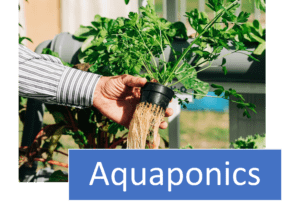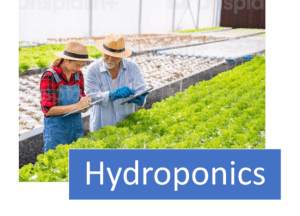Aquaponics and hydroponics are both methods of growing plants without soil. Aquaponics is a type of agriculture that combines traditional aquaculture (raising aquatic animals such as fish) with hydroponics (cultivating plants in water without soil). The wastewater from the fish tanks is used to fertilize the plants, and the plants in turn help to purify the water for the fish. This creates a symbiotic relationship between the two systems, where both the plants and the fish benefit.
 Aquaponics systems can be set up on a small scale for home or hobby use, or on a larger scale for commercial production. They are often used to grow a variety of vegetables, herbs, and other plants, and can be a sustainable and efficient way to produce food. Once set up, you just feed the fish.
Aquaponics systems can be set up on a small scale for home or hobby use, or on a larger scale for commercial production. They are often used to grow a variety of vegetables, herbs, and other plants, and can be a sustainable and efficient way to produce food. Once set up, you just feed the fish.
Hydroponics, on the other hand, is a method of growing plants in a nutrient-rich water solution rather than in soil. The plants are grown in containers filled with an inert growing medium, such as perlite or coconut coir, which helps to anchor the plants and provide some support.  The water solution is carefully balanced to provide the plants with all of the nutrients they need to grow and thrive. Because the growing conditions can be carefully controlled in a hydroponics system, plants can often grow faster and more efficiently than they would in soil. Hydroponics systems can be set up on a small scale for home or hobby use, or on a larger scale for commercial production. This is also used to grow a variety of vegetables, herbs, and other plants, and like aquaponics, is a sustainable and efficient way to produce food.
The water solution is carefully balanced to provide the plants with all of the nutrients they need to grow and thrive. Because the growing conditions can be carefully controlled in a hydroponics system, plants can often grow faster and more efficiently than they would in soil. Hydroponics systems can be set up on a small scale for home or hobby use, or on a larger scale for commercial production. This is also used to grow a variety of vegetables, herbs, and other plants, and like aquaponics, is a sustainable and efficient way to produce food.
Both aquaponics and hydroponics need a soil-less medium for the plants. Some of the soil-less products are Coconut coir, Hydroton, and gravel. Coconut coir has a high amount of salt especially with lower grades of product, whereas Hydroton, which is a clay-based type of ceramic pebble or bead, does not have this problem. This is highly favorable among most aquaponic users. Though the cost is a little high, it is well worth it. It is reusable from season to season. Both products work well in aquaponics or hydroponics. It all depends upon the user’s needs. Gravel is just pea-shaped gravel from your home improvement store. You can mix Hydroton and gravel to reduce your cost (and weight).
One key difference between aquaponics and hydroponics is that aquaponics relies on the interaction between fish and plants to create a balanced ecosystem, while hydroponics relies on the addition of nutrients to the water manually. Aquaponics systems are often more sustainable and self-sufficient, as they rely on the natural processes of the fish and plants to create a balanced ecosystem.
Speaking from the aquaponic side of the debate, I have found it to be very enjoyable and easy to use for numerous years. The easiest part is the lower maintenance. With seeds growing in soil, you have to keep watering the plants. This is not true when they are growing in water. This decreases the amount of time needed to spend on the plants. The only thing you need to concentrate on is the type of fish and the type of food you wish to use. Growing healthy fish means that your plants will be healthy as well.
Now the last thing I wanted to mention was the type of system you want to use. Not everybody is blessed with a large yard where they can put all kinds of big ponds for aquaponic and big systems for hydroponics, but there are many smaller systems for smaller areas. If you truly want to get into this system of gardening, do your research. Look at other systems available for backyards, porches, patios – they are way too numerous to mention here. To learn more or get started, try some of these resources below:
